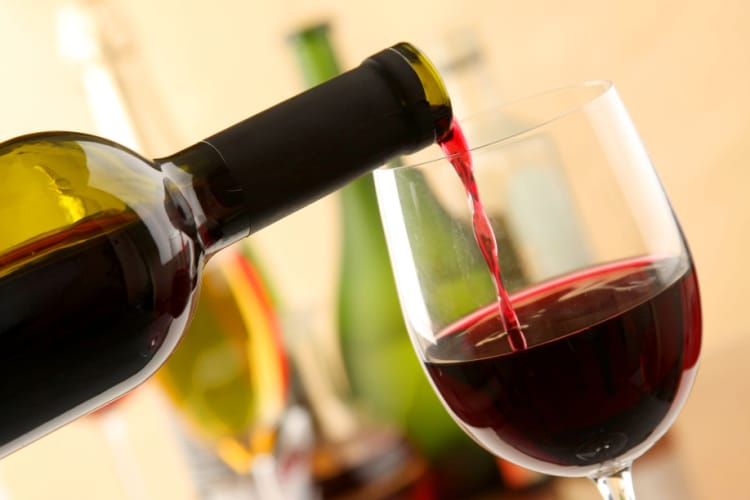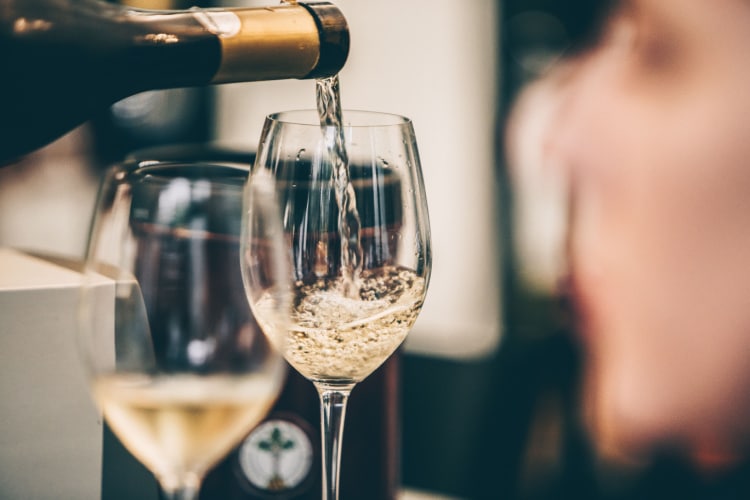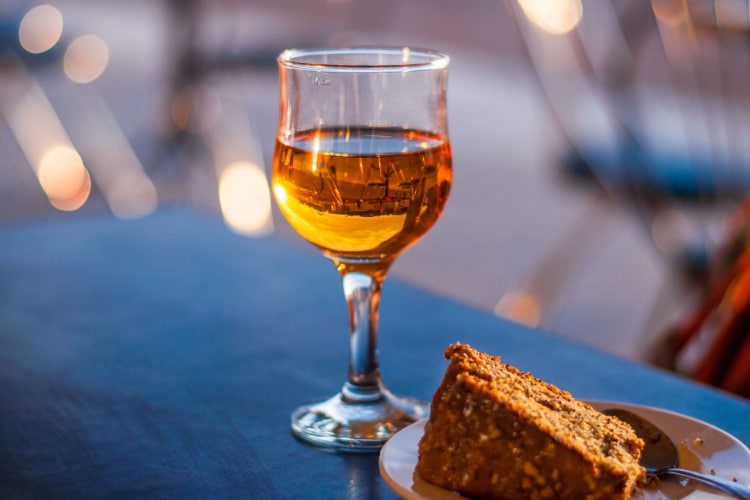Wine is one of the most confusing drinks. There are so many things to consider when choosing a bottle, from the acidity to what types of foods you’ll pair it with and even how old the bottle actually is.

In this comprehensive guide, we’ll talk about different types of wine, their characteristics, food pairing ideas, and more. By the end of it, you’ll be a true wine connoisseur.
5 Main Types of Wine
- Red wine
- White wine
- Rosé wine
- Sparkling wine
- Dessert wine
1. Red Wine

- Alcohol content: avg. 13.5% ABV
- Calories: avg. 85 per serving
Red wine is a fan favorite at dinner tables and events worldwide. Unlike white wines, reds derive their color from grape skins as they make content with the juices during fermentation. Red wine ranges from light red to deep, almost black tones.
Different wine varieties also have specific amounts of tannins, which are natural components of grape skins and seeds. Depending on the red wine grapes used in fermentation, they produce dry wine or its sweeter counterparts.
The grape variety used in crafting these wines can be found in several world wine regions, most of which practice oak aging in oak barrels. The world’s major wine regions are Burgundy, France, Tuscany, Italy, and, as of recently, Napa Valley, USA.
Red Wine Types
Some of the most popular red wine varieties among wine drinkers include:
- Cabernet Sauvignon: Known as the king of red wine. Cabernet Sauvignon is a full-bodied red wine rich in dark fruit, vanilla, or tobacco tannins.
- Merlot: A softer wine than Cabernet sauvignon and often drunk younger. Half of the red grape varieties used to make the Merlot are the same as the Cabernet.
- Pinot Noir: Famed for its delicate and light-bodied flavor, Pinot Noir is the trademark red wine of Burgundy, France, known for strawberry, raspberry, or floral tannins.
- Syrah/Shiraz: A full-bodied wine known as Shiraz in Australia and Syrah elsewhere. It’s mostly known for its intense fruit flavors, including blackberry, pepper, and spice.
Food Pairings
The intense flavors in red wine make it a perfect match for hearty foods:
- Red meat
- Steaks
- Lamb
- Heavy pasta
- Dark chocolate
Spices like black pepper, rosemary, and thyme also complement these wine characteristics beautifully, making your taste buds sing.
2. White Wine

- Alcohol content: avg. 10% ABV
- Calories: avg. 130 per serving
White wine is named after the white grapes used in the production, which give the sophisticated drink its beautiful color. White wines are well-known for their floral, fresh notes and lighter flavor.
Even though light-bodied white wine is usually the standard, you can find many full-bodied varieties in your local wine store. These bottles pack more of a punch, and they do so by offering more complex flavors with higher acidity and textures.
The color of this wine can range from pale yellow-green to rich gold. You may notice fresh apple, pear, and citrus notes, the most common ones when tasting. More complex tannins include vanilla, honey, and butter notes – typically in full-bodied white wine.
Two main regions are famous for their white wines: the Old World and the New World. The Old World, including France, Italy, and Germany, is noted for its traditional and classic white wines. The New World, including the Americas, South Africa, and Australia, is making a name for itself with vibrant and experimental white wines.
White Wine Types
Some of the most distinguished white wines are:
- Chardonnay: Known for the most famous white wine grapes in full-bodied white wines. It has a heavy, textured, and complex flavor.
- Sauvignon Blanc: Famous for its grassy and herbal flavors. Sauvignon blanc is more on the lighter side but can be somewhat acidic.
- Riesling: A white wine with a touch of tropical fruit notes. It’s lighter than Sauvignon Blanc, but it carries a heavier aroma.
- Pinot Grigio/Pinot Gris: Similar to the Pinot Noir, it’s among the sweet wines variety. The Pinot Grigio is lighter and less acidic but has dryer alternatives.
Food Pairings
These wine characteristics make it perfect for pairing with seafood dishes like fatty fish, mild cheeses, or creamy sauces. Wines like the Sauvignon Blanc also do wonders with salads, green veggies, spicy food, and Asian cuisine in general.
3. Rosé Wine

- Alcohol content: avg. 13% ABV
- Calories: avg. 147 per serving
Rosé wines combine attributes from both red and white wine, so they carry a delicate balance of sweetness and acidity. Typically, rosé wine is made from a variety of red and white grapes, which produce bright and fresh wines that are very tasty.
Due to this mixture, Rosé wines come in various colors, from pale blush to vibrant pink. Rosés are usually medium-bodied, combining the best of both worlds. This wine’s flavors usually include red and black fruit, melon, citrus, and subtle flowers.
Unlike heavy reds or rich whites, Rosés usually lower in tannins, so they taste fresher. Provence in France is the heart of this varietal wine, but other regions where this wine is famous are Rioja and Navara (Spain) and Veneto and Piedmont (Italy).
Rosé Wine Types
Some of the most sought-after rosés in the world include:
- Tavel: Crowned the king of rosés due to its complex palate.
- Provence: Famous for its delicate flavor and crisp, dry profile.
- White Zinfandel: Popular for its slightly sweet flavors and low alcohol content.
- Garnacha Rosado: A Spanish rosé renowned for its fruit flavors and high acidity.
- Pinot Noir Rosé: An elegant, delicate wine that revealed a strawberry-induced dryness.
Food Pairings
Rosé wine goes well with many dishes, depending on its bodied variety. Light rosés are great with light salads, pasta, and rice dishes.
Medium rosés are ideal for richer plates like cheesy pasta and spicy rice. And full-bodied rosés are perfect with white meats and smoked food.
4. Sparkling Wine

- Alcohol content: avg. 12% ABV
- Calories: avg. 83 per serving
Known for its fun bubbles and lively texture, sparkling wine is a broad term that embraces varietal wine types from different regions. They’re usually light, ranging from pale gold to rosy pink.
Sparkling wines fall into the ‘light to medium body’ category, but the grape varieties used in their productions can differ greatly. These wines’ flavors usually dance between citrus, apple, pear, bread dough, cream, and almond notes.
Sparkling wines are typically low in tannin, thanks to the wine’s high acidity. These wines are most known in the Champagne region, but you’ll also find bubbles in Italy’s Prosecco, Spain’s Cava, and other wineries in Australia, California, and beyond.
Sparkling Wine Types
Some of the most famous sparkling wines you’ll find in any wine shop include:
- Champagne: Also known as the king of bubbles, featuring elegance and complexity in every drop. It is usually made of Pinot Meunier, Chardonnay, or Chenin Blanc grapes.
- Prosecco: Dubbed as “Italy’s Champagne,” it’s known for its fruit flavors, floral notes, and subtle sweetness.
- Cava: Spain’s pride and glory, which offers a wide range of sparkling wines, from very dry to quite sweet.
- Sekt: An Australian-based wine known for its crisp acidity, which usually showcases notes of apple, pear, and citrus.
Food Pairings
Sparkling wine goes great with seafood, soft and creamy cheeses, and sugary desserts. You can also serve the wine alongside lemon juice for a lighter touch.
5. Dessert Wine

- Alcohol content: avg. 14% ABV
- Calories: avg. 230 per serving
Dessert wines are delicious treats, usually served after hearty meals. It’s a sweet wine meant to be enjoyed with dessert, but it goes quite well on its own. These wines are crafted from various grapes and natural sugars, which come in a full package.
These wines come in many colors, depending on the grapes used. Dessert wines are usually a mix of red grapes, black grapes, black cherry, and a hint of white grape varieties, so their hues range from golden to rich amber.
Wine lovers adore dessert wines for their full-bodied texture, which usually features tropical fruits, honey, and caramel notes. Because these wines are typically oak-aged with baking spices, you’ll also note earthy tones upon drinking. This sweet wine variety is mostly produced in France, Germany, and Portugal.
Dessert Wine Types
Some of the best dessert wines that’ll satisfy any sweet tooth include:
- Sauternes: An intensely sweet wine with notes of honey, apricot, peach, and tropical fruit. Its most notorious variety is Cabernet Franc.
- Eiswein (Ice Wine): An incredibly sugary wine with high acidity and fruit notes, including pear, apple, and tropical fruits.
- Riesling: A German fan-favorite, varying between dry and sweet. It often contains fruity notes of citrus, peach, and apple.
- Port: A rich and sweet wine, typically featuring strong flavors of black fruit, stone fruit, spice, and sometimes – chocolate.
Food Pairings
As its name suggests, dessert wine goes perfectly with sugary treats. Wine lovers love pairing this drink with chocolate desserts, nutty mixes, and fruit salads. However, dessert wines go well with certain types of cheeses as well, most notably – blue and salty cheese.
Other Wines to Try
Besides the main wines mentioned above, you’ll find that the world of wine is enormous. Some other fantastic wines you may want to try include fortified wines and, more specifically, Vermouth.
Fortified wine offers a unique depth of flavor and a long shelf life. They’re made by adding distilled spirits to the wine, giving them a higher alcohol content and a richer texture. The most notable fortified wines include Port, Sherry, and Madeira.
When on your fortified wine journey, you will certainly make a stop at the Vermouth station. This aromatized wine is flavored with many botanicals like roots, bark, flowers, seeds, and herbs. Vermouth can either be enjoyed straight or in cocktails like Martinis or Negronis.
Conclusion
Choosing the right wine can often seem overwhelming due to the variety of types, aromas, and flavors. But, having a general understanding of different types of wine can make this process much more enjoyable.
Whether you want a crisp Sauvignon Blanc, a full-bodied Cabernet, or a sweet Riesling, each wine offers its unique charm. So pop a bottle and remember that the final choice comes down to your preference and palate.